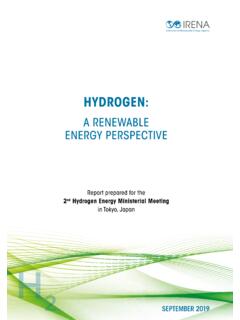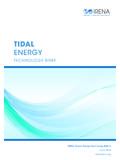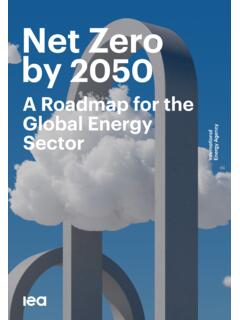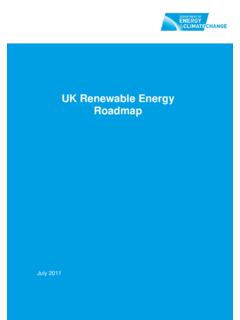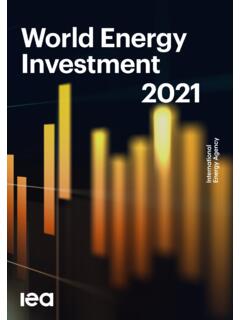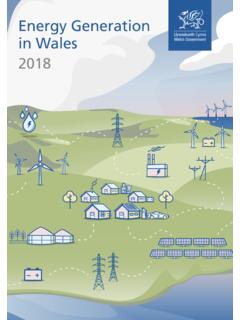Transcription of Wave Energy Technology Brief
1 WAVEENERGYTECHNOLOGY BRIEFIRENA Ocean Energy Technology Brief 4 June renewable Energy AgencyIRENAC opyright (c) IRENA 2014 Unless otherwise indicated, material in this publication may be used freely, shared or reprinted, so long as IRENA is acknowledged as the IRENAThe International renewable Energy Agency (IRENA) is an intergovernmental organisation that supports countries in their transition to a sustainable Energy future, and serves as the principal platform for international co-operation, a centre of excellence, and a repository of policy, Technology , resource and financial knowledge on renewable Energy . IRENA promotes the widespread adoption and sustainable use of all forms of renewable Energy , including bioenergy, geothermal, hydropower, ocean, solar and wind Energy , in the pursuit of sustainable development, Energy access, Energy security and low-carbon economic growth and prosperity.
2 ACKNOWLEDGEMENTSThe Brief has benefited from the participants of two review meetings on 21 January 2014 in Abu Dhabi, and 11 April 2014 in Brussels. Furthermore, very valuable feedback and comments have been received from Carlos Perez Collazo (Plymouth University), France Energies Marine, Davide Magagna (EC), Ana Brito e Melo (WavEC), Peter Mitchell (Seatricity), Dee Nunn (RenewableUK), Luis Villate (Technalia), Jochen Weilepp (Hochschule Biberach), and Miles Willis (Swansea University).Authors: Ruud Kempener (IRENA), Frank Neumann (IMIEU)For further information or to provide feedback, please contact: Ruud Kempener, IRENA Innovation and Technology Centre.
3 E-mail: or this publication promotes the adoption and use of renewable Energy , the International renewable Energy Agency does not endorse any particular project, product or service provider. The designations employed and the presentation of materials herein do not imply the expression of any opinion whatsoever on the part of the International renewable Energy Agency concerning the legal status of any country, territory, city or area or of its authorities, or concerning the delimitation of its frontiers or Energy | Technology Brief3 Highlights Process and Technology Status Wave Energy converters capture the en-ergy contained in ocean waves and use it to generate electricity.
4 There are three main categories; oscillating water columns that use trapped air pock-ets in a water column to drive a turbine; oscillating body converters that are floating or submerged devices using the wave motion (up/down, forwards/backwards, side to side) to generate electricity; and overtopping converters that use reservoirs to create a head and subsequently drive turbines. On top of that, each category can be subdivided according to the technologies used to convert wave Energy into pneumatic/mechanical Energy (rotation/translation), their power systems (air turbines, hydraulic turbines, hydraulic engines), their structures (fixed, floating, submerged), and their positioning within the ocean (shoreline, near shore, off shore).
5 More than 100 pilot and demonstration projects exist throughout the world, but only a handful of technologies are close to commercialisation. The next step on the road to commercialisation is the demonstration of wave Energy farms in the range of 10 megawatts (MW). Cost projections Due to the limited commercial experience, the estimates for levelised cost of electricity (LCOE) of wave Energy technologies in 10 MW demonstration projects is in the range of EUR 330-630 per megawatt-hour (/ MWh). However, there is considerable scope for economies of scale and learning, with the projected LCOE for wave Energy in 2030 estimated to be between EUR 113-226/MWh if deployment levels of more than 2 gigawatt (GW) are achieved.
6 Considerable research is going into improvements of the power take-off systems, which account for 22% of project life costs. In particular, efficiency improvements in air turbines (currently 50-60% efficient) and hydraulic systems to dampen the variability, are being explored. Furthermore, synergies with other offshore industries such as oil, gas and wind, are being pursued to reduce the costs of installation, operation and maintenance, and mooring (accounting for 41% of project life costs). Potential and Barriers With 2% of the world s 800 000 kilometre (km) of coastline exceeding a wave power density of 30 kilowatt per meter (kW/m), the estimated global technical potential is about 500 gigawatt electrical Energy (GWe) based on a conversion efficiency of 40%.
7 Large wave Energy resources can be found across the globe. At the same time, the wave regimes vary substantially across the different regions, resulting in a Wave Energy | Technology Brief4wide variety of technologies. Consequently, there is a lack of industrial cohesion and limited supply chains for the variety of components required. For both planning and Technology development purposes, synergies with other offshore industries would be advantageous to the wave Energy industry. Similarly, there are opportunities to create more dedicated infra-structures including ports and transmission grids to support the instal-lation and operation and maintenance of wave Energy Energy | Technology Brief5I.
8 Process and Technology StatusWave Energy converters (WECs) capture the Energy contained in ocean waves to generate electricity. Extracting Energy from ocean waves is not a recent phenomenon, as researchers have been studying different concepts or solutions since the 1970s. Nowadays, the Technology has evolved to a phase where different concepts are being tested at a full scale, pre-demonstration phase, and commercial demonstrations are being deployed. In 2013, there were more than a hundred projects at various stages of development, as esti-mated by some recent reviews (Falcao, 2010; Bahaj, 2011).There is a wide range of wave Energy technologies.
9 Each Technology uses dif-ferent solutions to absorb Energy from waves, and can be applied depending on the water depth and on the location (shoreline, near shore, off shore) (Cruz, 2008; Falcao, 2010). Although there is a wide range in technologies that sig-nals that the sector has not yet reached convergence, it also shows the many different alternatives to harness wave power under different conditions and evolution of the sector will aim for an initial deployment of demon-strating WECs in small arrays of 10 MW, close to shore or on specific testing emplacements. Making the jump to the full commercial phase requires some research on the basic components to reduce costs and increase the perfor-mance.
10 Also other solutions, such as hybrid or multiplatform concepts, could represent a solution that accelerates wave Technology development. These platf orms would combine wave Energy technologies with offshore wind turbines or with aquaculture farms, which would result in a sharing of the foundation system costs, lower operation and management costs, and some environmental benefits as the impact of a combined emplacement will be smaller than that with different Energy technologiesWave Energy technologies consist of a number of components: 1) the struc-ture and prime mover that captures the Energy of the wave, 2) foundation or mooring keeping the structure and prime mover in place, 3) the power take-off (PTO) system by which mechanical Energy is converted into electrical Energy , and 4) the control systems to safeguard and optimise performance in operating Energy | Technology Brief6 There are different ways in which wave Energy technologies can be categorised, , by the way the wave Energy is converted into mechani-cal Energy or by the Technology used.




